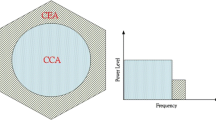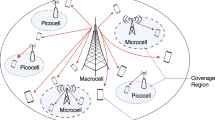Abstract
In cellular communication systems, directional multibeam antennas at cell sites can be used to reduce co‐channel interference, increase frequency reuse and improve system capacity. When combined with dynamic channel assignment (DCA), additional improvement is possible. We propose a multibeam scheme using dynamic channel assignment across multiple sectors. A cell is divided into several sectors, each of which is covered by several directional beams. Specific channels are allocated to each sector as in fixed channel assignment (FCA). A channel of a sector is dynamically assigned to a wireless user who communicates through one of the several beams of the sector. The assignment is made so that constraints on the allowable co‐channel interference are satisfied. Limitations due to co‐channel interference are analyzed. A tractable analytical model for the proposed scheme is developed using multidimensional birth–death processes. Theoretical traffic performance characteristics such as call blocking probability, forced termination probability, hand‐off activity, carried traffic and channel rearrangement rate are determined. With the proposed scheme, call blocking probability can be reduced significantly for a fixed offered traffic. Alternatively, system capacity can be increased while blocking probability is maintained below the required level. Smaller forced termination probability is obtainable in comparison with corresponding FCA schemes.
Similar content being viewed by others
References
G.K. Chan, Effects of sectorisztion on the spectrum efficiency of cellular radio systems, IEEE Transactions on Vehicular Technology 41(3) (August 1992) 217–225.
T.P. Chu and S.S. Rappaport, Generalized fixed channel assignment in microcellular communication systems, IEEE Transactions on Vehicular Technology 43(3) (August 1994) 713–721.
L.J. Cimini, G.J. Foschini, C.-L.I and Z. Miljanic, Call blocking performance of distributed algorithm for dynamic channel allocation in microcells, IEEE Transactions on Communications 42(8) (August 1994) 2600–2607.
R.B. Cooper, Introduction to Queuing Theory (Elsevier/North-Holland, New York, 2nd ed., 1981).
J. Fuhl and A.F. Molisch, Capacity enhancement and BER in a combined SDMA/TDMA system, in: Proc. 46th Vehicular Technology Conference, Atlanta, GA (1996) pp. 1481–1485.
L.C. Godara, Applications of antenna arrays to mobile communications, Part I: Performance improvement, feasibility, and system considerations, Proceedings of IEEE 85(7) (July 1997) 1029–1060.
M. Goldburg and R.H. Roy, The impact of SDMA on PCS system design, in: International Conference on Universal Personal Communications (ICUPC) (1994) pp. 242–246.
D. Hong and S.S. Rappaport, Traffic model and performance analysis for cellular mobile radiotelephone systems with prioritized and non-prioritized hand-off procedures, IEEE Transactions on Vehicular Technology 35 (1986) 77–92.
D. Hong and S.S. Rappaport, Priority oriented channel access for cellular systems serving vehicular and protable radio telephones, IEE (UK) Proceedings, Part I, Communications, Speech and Vision 136(5) (1989) 339–346.
W.C. Jakes, Microwave Mobile Communications (Wiley-Interscience, New York, 1974).
S.S. Kuek and W.C. Wong, Ordered dynamic channel assignment scheme with reassignment in highway microcells, IEEE Transactions on Vehicular Technology 41(3) (August 1992) 271–276.
W.C.Y. Lee, An optimum solution of the switching beam antenna system, in: Proc. 47th Vehicular Technology Conference (1997) pp. 170–172.
D.J.Y. Lee and C. Xu, Capacity and trunking efficiency of smart antenna, in: Proc. 47th Vehicular Technology Conference (1997) pp. 612–616.
Y. Li, M.J. Feuerstein and D.O. Reudink, Performance evaluation of a cellular base station multibeam antenna, IEEE Transactions on Vehicular Technology 46(1) (February 1997) 1–5.
V.H. MacDonald, The cellular concept, Bell System Technical Journal 58 (January 1979) 15–43.
T. Matsumoto, S. Nishioka and D.J. Hodder, Beam-selection performance analysis of a switched multibeam antenna system in mobile communications environments, IEEE Transactions on Vehicular Technology 46(1) (February 1997) 10–20.
R.A. Monzingo and T.W. Miller, Introduction to Adaptive Arrays (Wiley-Interscience, New York, 1980).
A.F. Naguib and T. Kailath, Capacity improvement with base-station antenna arrays in cellular CDMA, IEEE Transactions on Vehicular Technology 43(3) (August 1994) 691–698.
J.L. Pan, P.M. Djuric and S.S. Rappaport, Multibeam cellular communication systems with dynamic channel assignment across multiple sectors, in: Proceedings of Conference on Information Sciences and Systems (CISS), Session TA-2, Princeton (March 1998). Also see CEAS Technical Report No. 749, College of Engineering and Applied Sciences, State University of New York at Stony Brook, NY, July 10, 1997.
J.L. Pan, P.M. Djuric and S.S. Rappaport, Multibeam cellular communication systems with dynamic channel assignment, in: Proc. IEEE 48th Vehicular Technology Conference, Vol. 3, Ottawa, Canada (May 1998) pp. 2140–2144.
S.S. Rappaport, The multiple-call hand-off problem in high-capacity cellular communications systems, IEEE Transactions on Vehicular Technology 40(3) (August 1991) 546–557.
S.S. Rappaport, Blocking, hand-off and traffic performance for cellular communication systems with mixed platforms, IEE (UK) Proceedings, Part I, Communications, Speech and Vision 140(5) (October 1993) 389–401.
R. Rheinschmitt and M. Tangemann, Performance of sectorised spatial multiplex systems, in: Proc. 46th Vehicular Technology Conference, Atlanta, GA (1996) pp. 426–430.
S.C. Swales, M.A. Beach, D.J. Edwards and J.P. McGeehan, The performance enhancement of multibeam adaptive base-station antennas for cellular land mobile radio systems, IEEE Transactions on Vehicular Technology 39 (February 1990) 56–67.
K.L. Yeung and T.-S.P. Yum, Compact pattern based dynamic channel assignment for cellular mobile systems, IEEE Transactions on Vehicular Technology 43(4) (November 1994) 892–896.
K.L. Yeung and T.-S.P. Yum, Cell group decoupling analysis of a dynamic channel assignment strategy in linear microcellular radio systems, IEEE Transactions on Communications 43(2/3/4) (February/ March/April 1995) 1289–1292.
M. Zhang and T.-S.P. Yum, Comparisons of channel assignment strategies in cellular mobile telephone systems, IEEE Transactions on Vehicular Technology 38(4) (November 1989) 211–215.
Author information
Authors and Affiliations
Rights and permissions
About this article
Cite this article
Pan, J., Rappaport, S.S. & Djuric, P.M. Multibeam cellular communication systems with dynamic channel assignment across multiple sectors. Wireless Networks 5, 267–278 (1999). https://doi.org/10.1023/A:1019159313450
Issue Date:
DOI: https://doi.org/10.1023/A:1019159313450




